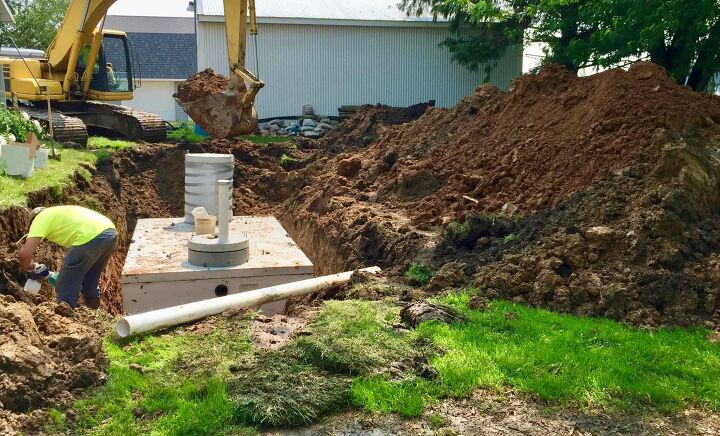Concrete Vs. Plastic Septic Tanks: Which One Is Better?

Septic tanks handle some of the most unpleasant household jobs. Without a functioning septic tank, the conditions inside your home may take a turn for the worse in a hurry. It’s important to take the time and get the best septic tank for your household.
Among the more popular options available today are the concrete and plastic septic tanks. Both options are viable in most households, but it’s certainly possible that one is a better fit for your home.
Concrete tanks are generally more durable and can hold up well in different kinds of environments. On the other hand, plastic tanks are more affordable and they’re also less susceptible to corrosion. It is worth noting though that plastic septic tanks are not allowed everywhere.
Numerous factors have to be considered when choosing between concrete and plastic septic tanks. Use the information in this article to make that decision easier.
Do You Need a Septic System Installation or Replacement?
Get free, zero-commitment quotes from pro contractors near you.

The Factors to Consider When Choosing between Concrete and Plastic Septic Tanks
Having multiple options is a good thing, but it can also inspire uncertainty. We want to help out homeowners who are just looking for the septic tank that fits their home best.
To do that, we’ve highlighted the different factors that matter most when deciding between concrete and plastic septic tanks. Weigh the following factors carefully if you want to make the right purchase.
Legality
The most important factor you have to consider when choosing between concrete and plastic septic tanks is legality. Not a lot of homeowners know this, but plastic septic tanks are not permitted everywhere. There may be laws in place that will prevent you from using a plastic septic tank on your property.
Make sure you double-check with the laws in your area before making any kind of purchase. You don’t want to waste money on a septic tank you cannot even use. Concrete septic tanks don’t face the same restrictions. You can use them anywhere throughout the country.
Overall Strength
In terms of sheer strength, concrete tanks come out well ahead of their plastic counterparts. If you have a concrete septic tank buried in your yard, you don’t have to worry a lot about accidental damage.
Now, this isn’t to say that you should just go ahead and drive over your concrete septic tank whenever you want. That’s still not a good idea.
What we are saying though is that concrete can handle that kind of force better than plastic. Mistakenly driving over your concrete tank a few times is not going to cause irreparable damage. Plastic does not possess the same kind of strength. It’s more likely to bend and possibly break underneath the weight of a moving vehicle.
You should go with concrete if you want a tank that can stand up to a lot of weight. Concrete tanks can also support some fixtures. That will come in handy if you want to load up your yard with various decorations.
Compatibility with the Surrounding Environment
The threats to your septic tank don’t just come from above. The structural integrity of your septic tank can also be compromised by the surrounding soil. Plastic septic tanks can be damaged by moving soil. The movements may even cause cracks to open up along the walls of the septic tank.
You also need to worry about tree roots if you’re opting to install a plastic septic tank. As the roots move around, they may start to reach your septic tank. Tree roots are capable of puncturing plastic septic tanks and dealing lasting damage.
Those potential concerns we just mentioned are less worrisome if you have a concrete tank. The concrete will hold up better to the tree roots and the shifting soil.
The only soil-related concern for concrete tanks is related to acidity. Acidic soil can wear down a concrete septic tank. The acidity level of your soil is not a major concern if you’re going with a plastic tank.
Corrosion Concerns
Septic tanks are supposed to stay inside your yard for years and even decades. During that time, there’s a good chance that corrosion will take place. Corrosion is mostly a concern with steel septic tanks. Steel septic tanks don’t last nearly as long as the concrete and plastic options mainly because of corrosion.
Still, you cannot forget about corrosion even if you’re choosing between concrete and plastic tanks. Concrete tanks are more susceptible to corrosion compared to plastic tanks. It will take a while before corrosion becomes an issue, but it’s still something to watch out for.
Stability
After the concrete tank is buried in your yard, you can count on it staying in place for a long time. Flooding in your yard or leaks in your plumbing system will not cause the concrete tank to suddenly shift in place.
Plastic tanks do not offer that same kind of stability. Too much water inside the plastic tank can cause it to start moving. Those movements are small, but they can still be damaging to your plumbing. Water coming from the surrounding soil can also cause the plastic tank to move a bit. Don’t be surprised if you start having issues with your plastic tank following a heavy downpour.
Porosity and Its Impact on Odors
Porosity is an important factor to consider when choosing between concrete and plastic septic tanks. Porosity matters for two reasons.
First off, the porosity material matters because it affects how difficult the tank is to clean. More porous materials are harder to clean because the nasty substances have more pockets to cling to. The other reason why porosity matters is due to the possibility of lingering odors. Simply put, more porous materials are likely to stink longer.
Both plastic and concrete are considered porous materials. However, concrete is way more porous than plastic. As a concrete tank ages, it will be harder to maintain. You may have to pump it more often just to get rid of the lingering smells.
Ease of Installation
Plastic tanks are easier to install than concrete options. That’s due in large part to weight.
It’s easier to transport plastic septic tanks because they are lighter. Once they’re on your property, plastic tanks are also easy to move around and position properly. Plastic septic tanks can also be installed without the need to use heavy equipment. You cannot say that about concrete tanks.
Depending on where you live, you may also have a hard time finding specialists who will install your concrete tank. Hauling around a big tank like that isn’t easy so some companies may decline if you live in a remote area.
You should also account for the installation time. Installing a plastic tank can be done quickly because it’s a relatively lightweight fixture. Concrete tanks cannot be installed as quickly.
Since your plumbing will be out of commission during the installation process, you must know how long the wait could take. If you’re not staying somewhere else, you may not be able to withstand the long installation time that concrete tanks need.
Price Range
There is a big gap between how much concrete and plastic septic tanks cost. It’s a big enough gap that it could be the determining factor in your decision. 1000-gallon plastic septic tanks have price tags in the range of $1100 to $1700. If you’re looking at concrete tanks with a similar capacity, the price range is usually set at $1300 to $2000.
By the way, you will also have to shoulder additional expenses if you’re getting a concrete tank installed. Specialists will usually charge more to install those concrete tanks because they are more difficult to work with.
Repair Options
Septic tanks are expensive. If you can repair instead of replacing them, that would be ideal. Plastic septic tanks are not easy to repair. Dents may not affect the tank’s performance too much, but cracks present a bigger problem. The entire tank could be rendered useless if enough cracks form.
Cracks are still problematic for concrete tanks, but they can be addressed more effectively. Smaller cracks can be patched up using fresh concrete. The concrete tank can stay strong after new material is used to fill in the cracks.
Do You Need a Septic System Installation or Replacement?
Get free, zero-commitment quotes from pro contractors near you.

Related Questions
What Are the Other Types of Septic Tanks?
Aside from concrete and plastic septic tanks, there are other options made available to homeowners. We already mentioned steel tanks earlier, although those are being phased out due to concerns about rusting.Fiberglass septic tanks are additional options for you to consider. Fiberglass tanks share a lot in common with plastic tanks. Many will point out though that the fiberglass tanks are typically stronger than the plastic options.You may have a hard time finding fiberglass tanks, however. Even if you want to install a fiberglass septic tank, one may not be available in your area.
What Are Septic Tank Lids Made Out Of?
Concrete and plastic are also the two materials most often used to make septic tank lids. In recent years though, plastic lids have grown in popularity thanks to how accessible they are. Many specialists now recommend replacing concrete lids with plastic so the tank is easier to maintain and inspect.

Gary Evans is passionate about home improvement. He loves finding out how to make improvements in the easiest, most practical, and most affordable ways. Upgrading his home kitchen is one of his ongoing hobbies. Gary is also a long-time content creator and enjoys spending his free time tending to his hydroponic vegetable garden.
More by Gary Evans



























